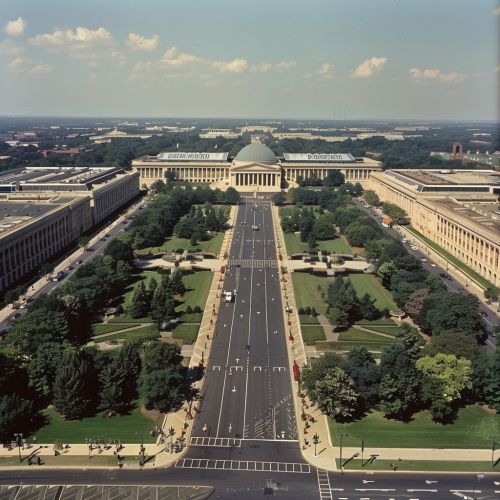United States Secretary of Defense: Difference between revisions
(Created page with "== Overview == The United States Secretary of Defense (SecDef) is the head of the Department of Defense (DoD), a key component of the federal government responsible for coordinating and supervising all agencies and functions of the government directly related to national security and the Armed Forces. The Secretary of Defense is a member of the President's Cabinet and is appointed by the President wit...") |
No edit summary |
||
| Line 58: | Line 58: | ||
* [[United States Armed Forces]] | * [[United States Armed Forces]] | ||
[[Image:Detail-91591.jpg|thumb|center|The Pentagon, headquarters of the United States Department of Defense.|class=only_on_mobile]] | |||
[[Image:Detail-91592.jpg|thumb|center|The Pentagon, headquarters of the United States Department of Defense.|class=only_on_desktop]] | |||
== References == | == References == | ||
Latest revision as of 13:41, 20 June 2024
Overview
The United States Secretary of Defense (SecDef) is the head of the Department of Defense (DoD), a key component of the federal government responsible for coordinating and supervising all agencies and functions of the government directly related to national security and the Armed Forces. The Secretary of Defense is a member of the President's Cabinet and is appointed by the President with the advice and consent of the Senate. The position is second only to the President in the military chain of command and is a principal advisor to the President on defense policy.
History
The position of Secretary of Defense was established by the National Security Act of 1947, which reorganized the military and intelligence agencies of the United States following World War II. The Act merged the Department of War and the Department of the Navy into the National Military Establishment, later renamed the Department of Defense in 1949. The first Secretary of Defense was James Forrestal, who served from 1947 to 1949.
Responsibilities
The Secretary of Defense has a wide range of responsibilities, including:
- Formulating and executing defense policies.
- Overseeing the DoD's budget and expenditures.
- Managing military personnel and resources.
- Supervising the Joint Chiefs of Staff.
- Coordinating with other federal agencies and international allies.
- Ensuring the readiness and modernization of the Armed Forces.
Organizational Structure
The Secretary of Defense is supported by several key officials and offices, including:
- Deputy Secretary of Defense: The principal assistant to the Secretary.
- Under Secretaries of Defense: Senior officials responsible for specific areas such as policy, acquisition, and intelligence.
- Assistant Secretaries of Defense: Officials who manage various functional areas within the DoD.
- Joint Chiefs of Staff: The highest-ranking military officers who provide military advice to the Secretary.
Appointment and Confirmation
The Secretary of Defense is nominated by the President and must be confirmed by the Senate. The nominee typically undergoes a rigorous vetting process, including background checks and hearings before the Senate Armed Services Committee. Once confirmed, the Secretary serves at the pleasure of the President and can be dismissed or replaced at any time.
Key Initiatives and Policies
Over the years, Secretaries of Defense have implemented various key initiatives and policies to address evolving threats and challenges. These include:
- Modernization of military technology and capabilities.
- Development of new defense strategies and doctrines.
- Enhancing cyber defense and information warfare capabilities.
- Strengthening alliances and partnerships with other nations.
- Addressing issues related to military personnel, such as recruitment, retention, and veterans' affairs.
Challenges and Controversies
The role of Secretary of Defense is not without its challenges and controversies. Some of the key issues that have faced Secretaries of Defense include:
- Balancing the need for a strong national defense with budget constraints.
- Managing conflicts and wars, such as the Vietnam War, Iraq War, and War in Afghanistan.
- Addressing internal issues within the military, such as sexual harassment and discrimination.
- Navigating complex international relations and geopolitical tensions.
Notable Secretaries of Defense
Several individuals have left a significant mark on the role of Secretary of Defense. Some of the most notable include:
- James Forrestal: The first Secretary of Defense, who played a key role in the early organization of the DoD.
- Robert McNamara: Known for his role during the Vietnam War and his efforts to modernize the military.
- Donald Rumsfeld: Served two non-consecutive terms and was a key figure in the post-9/11 military strategy.
- James Mattis: A retired Marine Corps general known for his emphasis on military readiness and alliances.
See Also
- United States Department of Defense
- Joint Chiefs of Staff
- National Security Act of 1947
- Deputy Secretary of Defense
- United States Armed Forces


